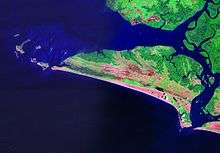Sherbro Island

| Sherbro Island, Sierra Leone | |
|---|---|
| Country | Sierra Leone |
| Province | Southern Province |
| District | Bonthe District |
| Population (2013 estimate) | |
| • Total | 28,457 |
| Time zone | Greenwich Mean Time (UTC±0) |
Sherbro Island is in the Atlantic Ocean, located in Bonthe District off the Southern Province of Sierra Leone. The Sherbro people make up by far the largest ethnic group in the island.
The island is separated from the African mainland by the Sherbro River in the north and the Sherbro Strait in the east. It is 32 miles (51 km) long and up to 15 miles (24 km) wide, covering an area of approximately 230 square miles (600 km2). The western extremity is Cape St. Ann. Bonthe, on the eastern end, is the chief port and commercial centre.
The island has more than 65 miles (105 km) of tropical beaches. It has been earmarked by the Ministry for Tourism and Development of Sierra Leone for tourism development.
Economic activities
Swamp-rice cultivation, tourism, and fishing are the main economic activities.
History
Sherbro Island was occupied by the Sherbro people, who did extensive fishing. After abolishing the international African slave trade in 1808 in partnership with the United States, Great Britain established a post on the island as a base for naval operations against illegal slave traders.
In 1815 Paul Cuffe, a successful ship maker and prominent African-American Quaker of Boston, Massachusetts, became interested in the resettlement of free American blacks in west Africa, as the British had done at Freetown in Sierra Leone since 1792. There Black Loyalists resettled from Nova Scotia had been joined by Maroons from Jamaica, Liberated Africans freed from illegal traders, and some of the ethnic groups in Sierra Leone interested in western culture. He believed that skilled free American blacks could help develop trade between Sierra Leone and the United States, and benefit both Africans and other free blacks in the US. Although he was personally successful, Cuffe well understood that many blacks labored against strong discrimination in the US. In 1815, he settled a group of 88 freedmen on Sherbro Island. After returning to the United States, Cuffe also sought to make a profit on the cargo he had taken on at Freetown.
After Cuffe's death in 1817, the American Colonization Society, founded in 1820 by both abolitionists and slaveholders, took a leadership role in resettling free American blacks in Africa. The members commissioned Samuel John Mills and Ebenezer Burgess to survey possible areas for a colony, including Sherbro Island. They conducted the survey along a tract of land between Sierra Leone and Sherbro Island. The surveyors found a group of colored people led by a freed slave named John Kizzel.
Mills and Burgess' report on their mission, recommending territory they thought favorable for settlement, contributed to the U.S. Congress' passing an act on March 3, 1819, authorizing the return of freed blacks to their "motherland". With this approval, the ACS began to establish a colony for American blacks in Africa. This black colony later became known as the Republic of Liberia. Most American blacks were born in the United States and felt that it was their country; they did not want to move to Africa but to gain equal rights and non-discriminatory treatment in the US.
In 1821, the first group of ACS-sponsored free blacks reached Sherbro Island. The ship Elizabeth left from New York with 86 free American blacks (including the missionary Daniel Coker) as well as three ACS agents. They intended a short stay at Sherbro Island, but disease and fever quickly killed more than a quarter of the would-be settlers.[1] The survivors relocated to Providence Island at Cape Mesurado in present-day Liberia in April 1822.[1]
The island was acquired from the Sherbro people in 1861 by the British Crown Colony at Freetown. It was administered under the colonial government until Sierra Leone achieved independence in 1961.
Environment
Sherbro Island is believed to be a breeding ground for green sea turtles as well as leatherback sea turtles.[2] The waters surrounding the island hold some of the biggest tarpon in the world. Records of the sportfishing organisation IGFA have been made by catches from this area.
Population
In May 2013, the Government of Sierra Leone's record of the island's population was 28,457.
References
Coordinates: 7°33′N 12°42′W / 7.550°N 12.700°W